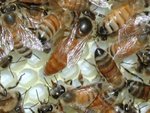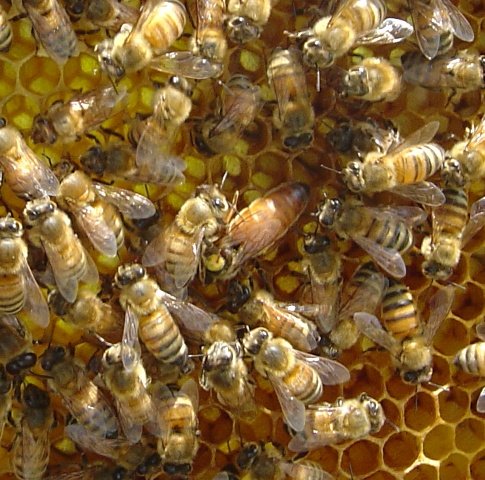
This week was an exciting beekeeping week for me.
.
A swarm of bees high in a scrub pine tree
.
Last Friday I went to visit a fellow beekeeper (John), at his home. He his hive had swarmed a day earlier, and we were going to inspect his hive to see what condition they had been left in. I have never worked with a more gentle bee. We probably did not have to use any smoke or where a veil or gloves.
.
.

A closer look at the swarm
.
Inside the hive we found four queen cells. The hive was started last year, and according to John over-wintered well. Our inspection showed that only 13-14 of the frames in the double brood chamber (of 20 deep frames) had been drawn out. Of course the bees were working on storing honey in the honey super though. The brood chamber was crowded with honey. This is probably the reason the hive swarmed. It was honey bound. Any extra room the bees were making by building comb was being filled with honey. There was no place for the queen to lay, so the bees must have felt crowded even though there were 6 or 7 empty frames in the brood
 chamber and plenty of space in the honey super. As happens more times than not on Cape Cod, the swarm ended up landing at the top of a large scrub pine tree. It is hard enough getting a swarm out of a scrub pine, never mind them being 80 feet up in the air.
chamber and plenty of space in the honey super. As happens more times than not on Cape Cod, the swarm ended up landing at the top of a large scrub pine tree. It is hard enough getting a swarm out of a scrub pine, never mind them being 80 feet up in the air..
John with his bees
.
John had contacted another beekeeper who brought over an empty nuc box and had placed it up in the tree (about 12 feet up) in hopes that the swarm would find it and make it their new home. John would have then had two hives of bees.
On Saturday I worked my bees. Three of the hives were examined for swarm cells. My strong hive had started building cells, but there were no eggs in them. Since there were so many bees I took three frames, Two capped brood and one with eggs and young larva, and placed them in a nuc box with a division board feeder filled with sugar syrup. I assumed that the bees would realize they had no queen and build queen cells from the larva. Empty drawn comb was placed in the old hive where the frames had been taken. Since this strong hive contains the queen I want to breed, I prepared a special frame of foundation and placed it in the center of the brood chamber. I plan to raise new queens (by the miller method) from this frame once the old queen lays eggs in it. I had planned to come back in 4 days to remove the frame, but mother nature delayed me with cold wet weather this week. Temperatures dropped to the low 40’s and it was wet.
 .
.A special frame (miller method) prepared for raising queens
.
There was a short break in the weather today. Clouds and rain are expected to move in tonight for the weekend. In beekeeping you need to take your opportunities when they come.
My first step was to create a queenless cell builder hive. I spent the winter researching queen rearing, and dreaming about my plans to raise queens for myself and my beekeeping friends. A queenless cell builder hive is a deep box of bees with specific types of frames of bees. The order I used was as follows (from left to right) Open nectar, Capped Brood, Capped Brood, Pollen, Empty space, Eggs & Larva, Empty space, Pollen, Capped Brood, Open nectar.

.
My Cell Bulder Hive notes from this winter.
.
The eggs from the “mother queen” are placed in the empty spaces. I ended up taking frames from my two strongest hives, since I have been concerned they might swarm within the next few weeks. The cell builder needs to be continuously fed, so a hive top bucket feeder was installed on top of the inner cover of the cell builder.
The next step was to examine the “miller” frame I had installed on the 1st, to see if the bees had drawn out the comb, and if the queen had laid eggs in it. Sure enough I pulled out the frame to find the queen walking across it. The bees had drawn out almost the entire frame. There were eggs mixed with nectar in the frame. I gently moved the “mother queen” off the frame into the hive, and placed frame with the eggs into the cell builder.
 .
.The assembled cell builder with space for eggs. The fifth frame is the miller frame taken from the "mother hive".
.
The order of frames I used is as follows (from left to right) Open nectar, Capped Brood, Capped Brood, Pollen, Empty space (miller frame), Eggs & Larva, Empty space, Pollen, Capped Brood, Open nectar.
.
Now the timing begins. It takes 16 days to raise a queen from egg to adult. I will assume that the frame of eggs is 1 to 2 days old. That means that any queen cells raised from this frame of eggs would be ready to hatch on June 22nd. Each queen cell will need to be placed in a separate mating hive prior to the emergence of the virgin queen. More on that next time.
.
 .
.The finished cell builder with a hive top feeder and cover.
.
Of course with all these manipulations something was bound to happen. As I was examining the “mother hive” I knocked over four boxes of bees. While my back was turned they tipped over and came crashing down to the ground. Boy were their a lot of bees flying around. It took about half an hour to put the hive back together again with the frames back in their respective places. I did find the “mother queen” and she looked unharmed.
.
.
.
The next hive inspection in a few days will reveal if she is still laying eggs as well as she has been.
.
.
Below. My first "intended" queen cell. This one cell was built by the bees in the Nuc box I created on June 1st. The queen quality cannot be determined because the age of the larva used to create this cell was uncontroled. The cell is capped and should emerge within 5 days.










I'm sure those four bee boxes just snuck up behind you, didn't they. Those bee hives can be quite stealthy when they want to be :)
ReplyDelete